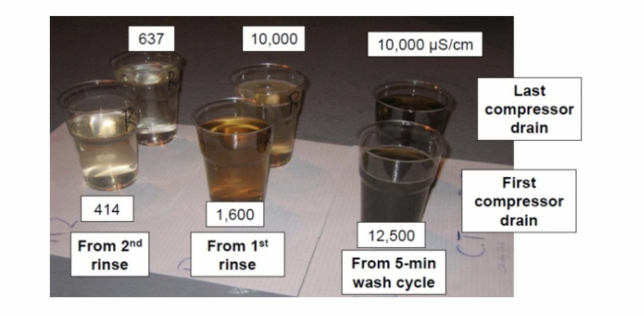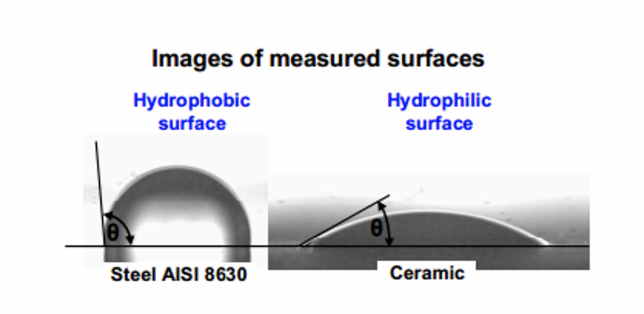The essentials of turbine cleaning
A Review of Compressor Cleaning Options and Best Practices
The purpose of owning and running a gas turbine (GT) is to harness work. As a fouled turbine lowers output and throughput, cleaning must be done correctly to maintain a productive, profitable turbine.
Fouling consists of deposited airborne particles ingested from the environment. These can include salts and minerals or hydrocarbons, as well as aggressive gases such as SOx, NOx or chlorine. Once these particles adhere to the compressor blading, surface roughness increases. This impacts aerodynamic and compressor performance.
In addition, ingested pollution contributes to blade corrosion. These chemicals react with moisture from the environment to create acidic compounds that reduce the operational life of the machine and raise maintenance costs.
As bleed air can be contaminated by foulants entering the cooling system, fouling can block or partially block cooling passages in hot section stators and blades. This results in accelerated thermal fatigue.

Table 1: Advantages and disadvantages of different cleaning regimes[/caption]
There are four main cleaning options (Table 1), each with advantages and disadvantages. Abrasive cleaning is seldom carried out anymore due to its risk potential. The other three are performed regularly on GTs of varying sizes across the world.
A review was done of the net work produced before and after a wash on a 45 MW turbine collected over 15 weeks at one plant. An increase of 35% net work is seen when using a combination of, offline and hand washing. When only online washing is carried out, performance is also boosted, albeit with a downward trend post-wash. It is recommended, therefore, that both online and offline washing are used as they can be carried out during operation and require no shutdown (Figure 1).

Figure 1: Effect of cleaning on net work using various compressor washing techniques.[/caption]
Water or chemicals
The question of whether to use water or chemicals should be considered on a case to case basis. It depends on the type of fouling seen. Fouling elements can originate from the environment, fuel impurities, corrosion, or leakages. Some of this can be mitigated with fuel selection and effective maintenance schedules. To maximize efficiency returns, the right injection fluid must be selected.
The three main categories of wash fluid are demineralised water, hydrocarbon aromatic solvent, and surfactant-based fluids. A mixture can be used to widen the effective range of foulant removal (Table 2).

Table 2: Types of injection fluids[/caption]
Some operators are moving away from hydrocarbon solvent-based wash fluids, preferring fluids they can dispose of more easily and that require fewer safety considerations. Many of the most popular fluids on the market are surfactant based, which are well suited to capturing foulant and carrying it through the engine without redepositing on later stages.
Another consideration when selecting wash fluids is foaming and how long the foam takes to rinse out of the turbine. Excessive foaming can extend wash times and the number of rinse cycles with an associated increase in the volume of wash effluent requiring disposal management. On the other hand, foam increases the surface area of the fluid. This enhances fluid distribution and the foulant penetration. This also enables the foulant to be carried out of the engine more effectively.
Operators are advised to perform an effectiveness test with a foulant sample to ensure the right chemical is selected. Effectiveness can vary widely based on foulant composition and chemical brand.
In a heavily salt-laden environment, a water wash may be the most effective type of wash. But in most other environments, the foulant will be a regular surfactant mixed water wash. Ideally, it should be used in conjunction with a less frequent offline solvent or solvent mix wash to remove heavy/difficult fouling if the seals permit it. Once foulant has been removed by the wash fluid, it passes further into the GT compressor. It is usually expelled out of the exhaust or drained from the compressor along with the wash fluid.
To ensure no significant build-up occurs in later compressor stages, a regular offline wash should be performed with a suitable number of rinse cycles, ensuring the effluent is within recommended boundaries for conductivity and appearance. The effluent taken from successive rinse cycles shows a definite change in conductivity and appearance (Figure 2). This suggests the offline wash only loosens the dirt; it is the rinse cycle that removes it from the compressor. This highlights the importance of offline cleaning to remove foulant and any later-stage deposits.

Figure 2: Effluent samples taken during an offline wash.[/caption]
Erosion and wettability
If done incorrectly, compressor cleaning can unintentionally cause more damage due to erosion. Material erosion is dependent on droplet velocity and material exposure. Larger droplets, higher velocities or longer exposures create higher erosion rates. However, a threshold must be crossed before any erosion takes place or material is removed.
Smaller particles travel at much higher velocities than larger but are less lightly to impinge on the surface. With less impingement one would expect to see less erosion or material loss. This suggests that as particle size reduces, the velocity threshold where erosion occurs rises. Further, a small amount of friction is necessary for the removal of foulant. However, too much will cause damage to turbine blades by removing material. A spray with a 100-250µm average droplet size (Sauter mean diameter) will be large enough to remove foulant, but not so big as to pass their velocity threshold and cause damage.
The factor of wettability must be considered with regard to cleaning effectiveness. Wettability is measured by the contact angle of droplets. Hydrophilic surfaces allow droplets to spread wide, giving a low contact angle below 90°. On hydrophobic surfaces, droplets keep their shape with contact angles over 90° (Figure 3). Typically, metallic materials are hydrophobic while ceramics tend to have very good wettability. GT compressor blades are generally made from titanium which is hydrophobic. Thus, one would expect them to have limited wettability. However, modern compressor blades have ceramic coatings to improve heat resistance. Their secondary benefit is enhanced wettability with a much lower contact angle than titanium alone.

Figure 3: Contact angle of different surfaces[/caption]
For the wash fluid to properly coat the turbine blades, viscosity also plays a key role. High viscosity fluids take longer to spread over the surface, limiting cleaning effectiveness. It appears that viscosity has a greater effect on wetting time than on the contact angle with little change when the contact angle is increased. This is relevant to GT applications as injected droplets have limited contact time with compressor blades; the shorter the wetting time, the better fluid will cover and clean the surface.
Online cleans require specialist hardware that may not be have been installed when the machinery was manufactured. However, it is often possible to retrofit this hardware and add online cleans to the maintenance schedule. ■
